The country with one people and 1,200 sausages
- Published
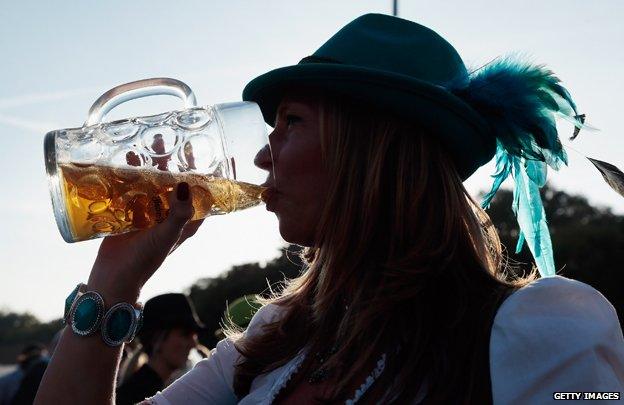
The Oktoberfest is the largest popular festival in the world - larger, it's claimed, than Mardi Gras in New Orleans or Carnival in Rio. Created by Bavarian King Ludwig I to celebrate his wedding in 1810, it encapsulates German-ness in a way everyone can engage with - and every year hundreds of thousands do.
The British Museum has in its collection drinking vessels from all around the world, but the German collection is striking for its quantity of glasses, mugs, tankards and other vessels - primarily made for the drinking of beer. Mostly from the 16th and 17th Centuries, they're made of all sorts of different materials, and they come from everywhere in the German-speaking world.
Tall glasses from Switzerland, stoneware tankards from Cologne, covered beakers from Austria, and silver-gilt mugs from Hamburg and the German-speaking merchant cities of the Baltic, all the way from Luebeck to Riga. But most astonishing of all is this tankard made entirely out of amber - the exotic, expensive, exclusive material found abundantly in East Prussia. Looking at this array, it is clear that Germans everywhere not only enjoy beer, but celebrate it in style.
And they seem to have been doing it for at least 2,000 years. In fact it is almost the first thing that any foreigner wrote about them.
Around 100 AD the Roman historian Tacitus, in his Germania, talks of the fair-haired, blue-eyed tribes which had given the legions such trouble along the Rhine, of the more distant ones who gathered amber on the Baltic, and of what they all had in common: "A liquor for drinking is made of barley or other grain, and fermented into a certain resemblance to wine. To pass an entire day and night in drinking disgraces no one."
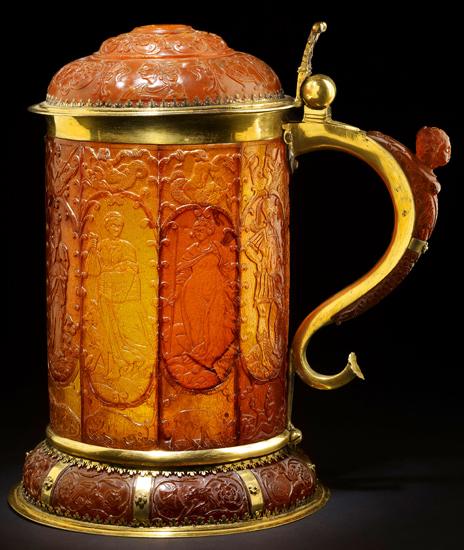
Later archaeology confirmed Tacitus's observation of heavy, happy drinking among the German tribes. This is in part why, when Germany later needed to forge a new sense of identity, beer in the 19th Century became a touchstone of being German.
"If you look at pictures of the 19th Century, the painters loved to depict the Germans combining bear and beer: lying on bearskins, bear furs… sipping enormous quantities of beer from gilded ox horns," says Peter Peter, the food correspondent of the Frankfurter Allgemeine Zeitung.
"Beer was a national cause... Look at the enormous beer halls, especially Munich: those architects were inspired by Wagnerian dreams of Nordic heroes, of epic sagas."
It's rather as though the 19th Century English had discovered Boadicea's favourite tipple and made it their national drink. When these German nationalists, eager to discover grand German traditions, set to work on the symbolic status of beer, as well as quoting Tacitus, they unearthed the Bavarian Reinheitsgebot, the Beer Purity Law, first promulgated in 1487 by Duke Albrecht IV of Bavaria.

Find out more
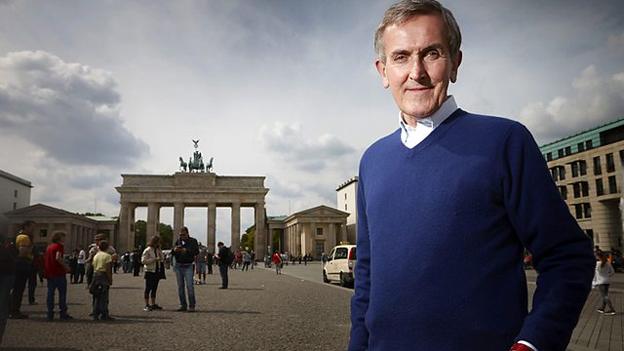
Neil MacGregor, director of the British Museum, explores 600 years of Germany's complex and often challenging history, using objects, art, landmarks and literature in Germany: Memories of a Nation on BBC Radio 4. The series begins on Monday 29 September at 09:45 BST. You can also download the podcast later.

This Purity Law became the basis of some very successful myth-making. The 19th Century nationalists assumed it was designed to make sure that only clean, unpolluted water was used to brew beer: evidence that the integrity of the national drink had been defended for centuries. It is an assumption still widely accepted as true, but Harald Scholl, of the Munich Slow Food convivium, thinks otherwise.
"The German Reinheitsgebot means that you are just allowed to use a few things to make beer - which is barley, hops, and water and nothing else," he says.
"And it was a political thing, to do this. It had nothing to do with preventing the people from getting ill - it was just to prevent them from brewing with wheat or rye, because wheat and rye was used for bread."
Though the original Beer Purity Law was Bavarian, it was quickly adopted in many other parts of Germany - the devastation of northern Germany during the Thirty Years' War (1618-1649), and the consequent scarcity of grain for bread, made it seem a valuable regulation for preserving food supplies. It is a measure of how successfully the mythical union of beer and national identity had been fostered, that in 1871, during negotiations over German unification, Bavaria made the adoption of the Beer Purity Law a condition of its joining the new German Empire.
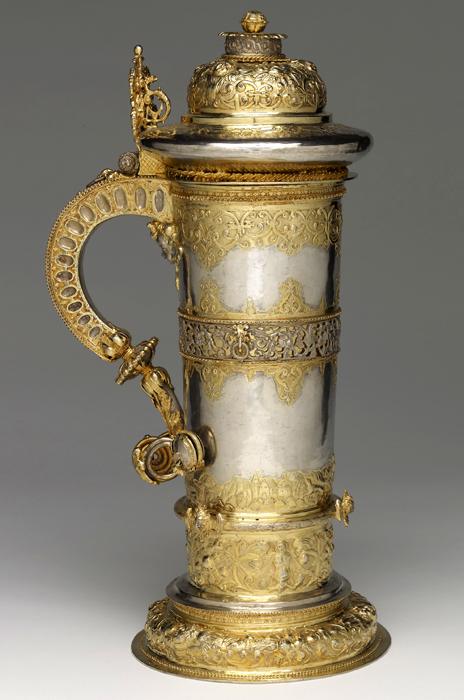
Astonishingly, the issue arose again at the reunification of East and West Germany in 1990. Across Germany the so-called Brandenburg Beer War fought out in the courts, lasted for 10 years - all over a black beer brewed in the former GDR that contained sugar, something forbidden by the Purity Law.
Regional beers, as Harald Scholl describes, are what have defined German towns, cities and localities for centuries.
"Of course we have a tradition of regional brewing in Germany. When you look to upper Franconia, there you find real handmade beers from tiny breweries, brewed with a special barley which is malted. You have some sort of smoke beer, Rauchbier, in Bamberg which is very, very special - when you think of an Islay malt [whisky] with its distinct taste, you find it in this beer also," he says.
And that sense of strong local identity is strikingly apparent on the beer tankards in the British Museum. On one after another, they display the arms of the different cities or the different princes. These drinking cups, made by master craftsmen out of precious materials, are clearly intended as statements of civic pride.
They also have a very significant function to perform. Legal contracts, trade deals, oaths of allegiance were often concluded by Zutrinken, a pledge of good faith - drunk usually in beer - not unlike a handshake that seals the deal. Out of grand ceremonial tankards like these, the different parties to the agreement would drink in turn, in a public, ceremonial act of assent. Given the size of some of the tankards - in some cases, several litres - it seems that Tacitus was not exaggerating when he described the German fondness for drinking.
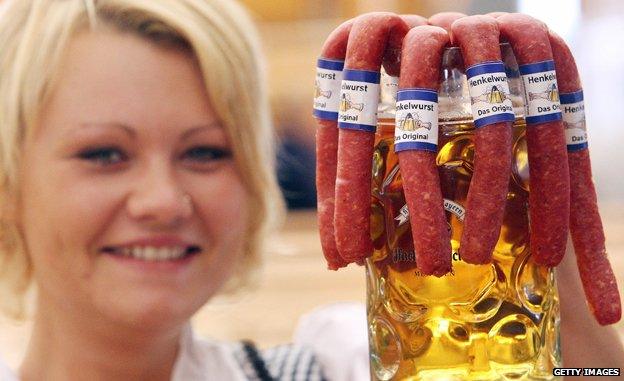
To go with the beer, there is the other great emblem of Germany's national diet - wurst, the sausage. Wurst, like beer, defines Germany's cities and regions. Quite apart from the obvious ones like the Frankfurter, there is Bratwurst from Franconia, Bregenwurst from Saxony, Pinkel from Bremen, Teewurst from Pomerania, and Weisswurst from Bavaria. Every region has its wurst and it's claimed that there are 1,200 of them - that's more than three times as many as the French have cheeses.
In Britain our national dishes are traditionally roast beef, and fish and chips, but how many of us know how, when, where they originated? How many of us care? It is quite different in Germany: beer and sausage embody centuries of national, regional and local history, they are living assertions of local diversity and regional trading links - the gastronomic equivalents of the flourishing regional dialects. They have a special place in the regional and local memory - and indeed in the national psyche.
Peter Peter describes sausage as "history on the plate".
"Traditionally, manufacturing sausages was a very complicated feat of craftsmanship - you needed a lot of experience to mince the meat, to add exotic spices to preserve it," he says.
"So it was the pride and privilege of German free towns, and still nowadays, a lot of sausages bear the names of historically relevant towns."
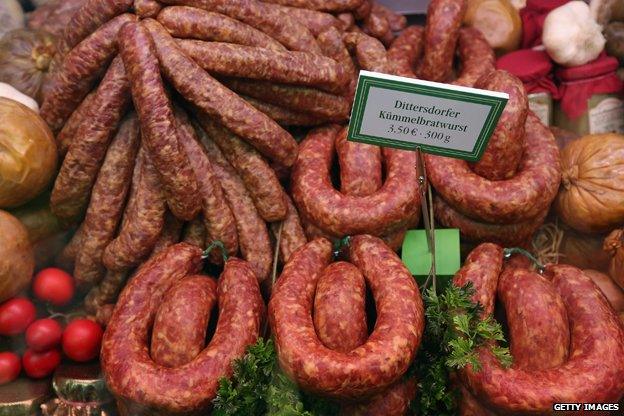
Take the Nurembergers from Nuremberg, for example, small sausages about the size of a finger.
"They have added cinnamon and other spices. Because Nuremberg was the twin city of Venice, they had a privileged access to the oriental spices."
The nuremberger sausage may not be familiar to non-Germans, but everyone knows the frankfurter. The basic, bland sausage in a bun is available on nearly every street corner across Germany, and across Europe and America as well: smoky, finely minced meat, almost to a paste, then plastered with mustard or tomato ketchup. But the frankfurter did not begin like that.
"The frankfurter, the famous frankfurter, they started as a coronation sausage, in Frankfurt for the Roman emperor," explains Peter.
"They grilled an ox when the emperor was crowned and they filled it with these sausages and it was luxury because of the finest mincemeat. People abroad bought these things because the name of Frankfurt gave them the idea of luxury."
So next time you tuck into a frankfurter, just think for a moment of the link between the humble hot dog and the imperial pageantry in Frankfurt Cathedral.
In the late 19th Century, food production became mechanised in Germany, as it did elsewhere, and wurst manufacture, traditionally a cottage industry, fell victim to the trend. The ability to finely mince meat was no longer a sign of quality and craftsmanship - instead it allowed anything, and frequently everything, to be included in the sausage, making it the food of the proletarian poor. And in Berlin, the fastest growing city in Europe at the time. It became notoriously difficult to be sure what was actually in a Berlin sausage. Hence the famous - though probably apocryphal - remark by Bismarck, that citizens do not really want to know how either laws or sausages are made.
Fifty years later, the poor quality of Berlin sausages was to have a very unexpected consequence. Museums are dedicated to material evidence, and, disappointingly, sausages leave few physical traces. Unlike beer, with its rich legacy of glasses and tankards, sausages have few dishes or utensils that are exclusively connected to them, and so museums struggle to tell the tale of the wurst.
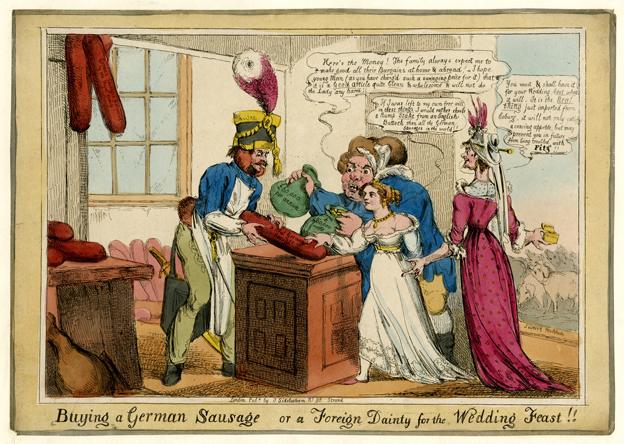
In the British Museum we can muster little more than some suggestive cartoons about 18th Century royal weddings. Which is why it was with surprise and delight that, a few years ago, the international museum community discovered that we all had a new colleague, the Currywurst Museum in Berlin, located just beside Checkpoint Charlie - the most famous crossing point in the Berlin Wall, until it was knocked down in 1989.
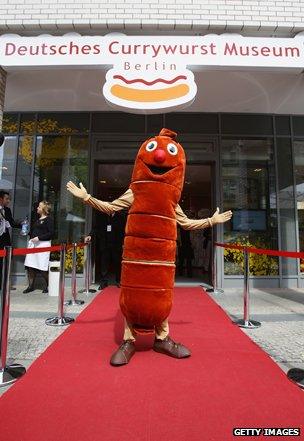
The opening of Berlin's Currywurst Museum
The museum's existence speaks of the astounding success of a very late arrival on the wurst scene, not the heir to proud traditions of an Imperial Free City, but the result of food shortages in post-1945 Berlin. Parodying John Maynard Keynes, who wrote a book about The Economic Consequences of the Peace, you might say that the currywurst is one of The Gastronomic Consequences of the Peace. And it is still very much with us - an essential part of the Berlin experience.
"Currywurst was invented by the help of an unknown British soldier, who sold curry powder on the black market in Berlin in the late 40s. And for these very cheap sausages, they need some sensory contrast, so they decided to sprinkle curry powder on the sausage," says Peter.
"It was a time when we frenetically discovered foreign dishes, so it was interesting having something Indian, something exotic. It became a symbol of a town that had never had excellent sausages.
"After 1989, Berlin became very popular; a lot of Germans discovered Berlin - so going to a currywurst stall became an experience of a lot of young people. So a dish that in a certain way is a white trash dish became a symbol of visiting Berlin, of young lifestyle."
To the British observer, Germany is a nation of startling diversity. Regional specialities represent centuries of regional history - different beers and locally distinct sausages, all managed by national regulations that began 500 years ago and that say one thing: This is German.
Neil MacGregor's series Germany: Memories of a Nationis on BBC Radio 4, starting on Monday 29 September at 09:45 BST. You can alsodownload the podcastlater.
Subscribe to the BBC News Magazine's email newsletter to get articles sent to your inbox.